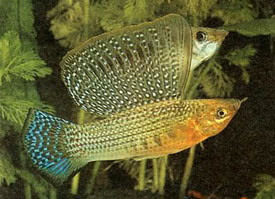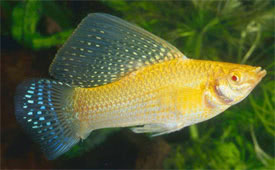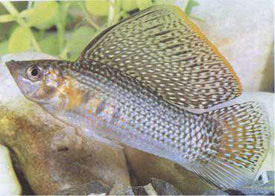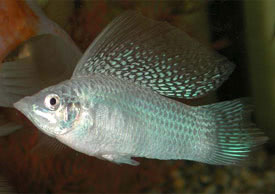
 Magyarul / Hungarian
Magyarul / Hungarian



- Scientific name : Poecilia velifera
- Common name: Sailfin molly
- Group: Livebearers
- Habitat: Central America; Mexico
- Size: Males:12-15 cm, females:18-20 cm
- Biotope: Coastal areas in Yucatan, Mexico.
- Social behavior: A peaceful, community fish. Keep one male with several females.This fish should be combined with fishthat can also tolerate hard, neutral to alkaline water.After acclimation, fish may be kept in a marine tank.
- Diet: Algae, live, worms, crustaceans, insects, insect larvae, plant matter
- Breeding: Easy
- Tank: Minimum 200 litres
- Population: 1 male and 2-3 females for 200 litres
- Decoration: The tank should be well-planted and have lots of open swimming area so that the sailfin of the male can develop
- Temperature: 27-29 °C
- pH: 7,5-8,5
- Hardness: 13-19 NK°
- Lifespan: 4-5 years
Description: Very similar to Poecilia latipinna, with the major difference being the markings on the Dorsal fin in Poecilia velifera they small,round light spots while in Poecilia latipinna they are dark and rectangular. Males can reach a length of six inches and the females even larger.
This is one of the most beautiful livebearers you will see. The sides are Blue-Green with iridescent greenish, Silver or pale Blue dots. Between the dots are dark Blue to Copper color bands that extend all the way to the Caudal fin. The Belly and throat area is also Bluish, Green or Orange. The Dorsal and Caudal fins are marked with Pearly dots and are edged in Orange, Brown or Black. The female is very similar to the male but with less vibrant colors.
These pretty fish are best kept alone or with other Livebearers in large well planted aquariums. They prefer a little sea salt in their water (one teaspoon to two gallons of water). In addition to live and flake food their diet should be supplemented with some plant material. The males large fins depend on the nutrients from the plant food and may not develop properly if they are not received. These are a temperate zone fish and can tolerate fairly low water temperatures, but they do prefer the range of 75 to 82 degrees F.
As the male matures the Anal fin develops into a structure for reproduction called the Gonopodium. The Gonopodium can be moved in almost any direction and stores the sperm in packs called spermatophores. Once the sperm is inserted into the female it fertilizers her eggs and the rest is stored in the Oviduct walls for later use. The eggs are very rich in yolk and the young develop by consuming their yolk stores. In light colored females pregnancy can be recognized by the growing dark body marking in front of the Anal fin. Young Live-bearers are fairly large at birth and their development is very advanced. They can swim right away, which is needed to avoid their enemies including their parents who give no natal care whatsoever. The fry grow very rapidly and will eagerly accept fine flake food. The number of fry is variable due to the size differences in the species, but in larger females can number well over one hundred.


